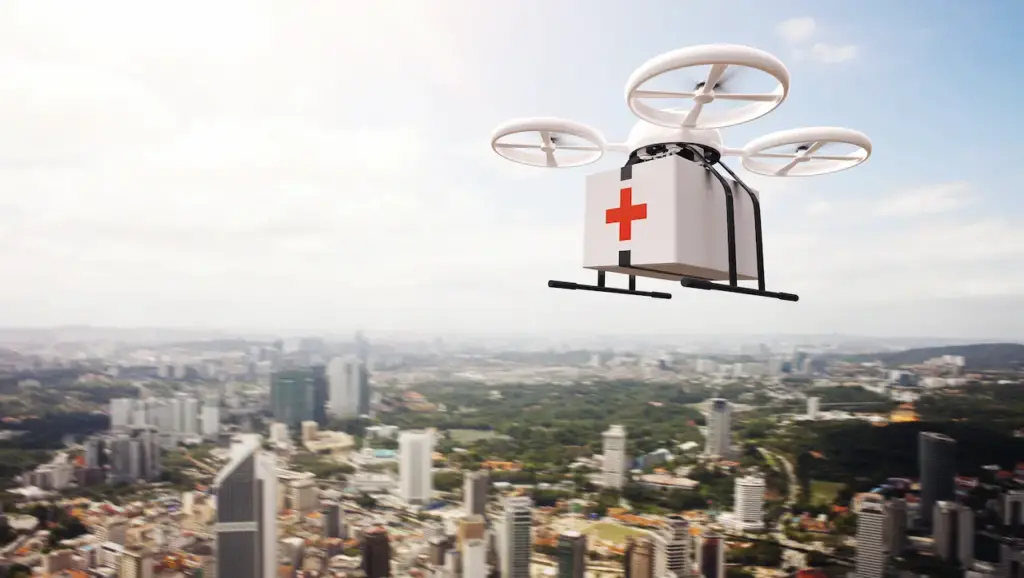Drones are playing a major role in the effort to stop the coronavirus outbreak. Some of their work is being largely lauded, such as delivering medical supplies. But some of the drones working in the midst of the outbreak are also quite controversial, such as the drones that fly around in search of people not wearing masks — prompting concerns of drones being used for over-surveillance.
Here are some of the ways drones are flying in China during the coronavirus outbreak:

Delivering medical supplies
Drones have spent the past few years delivering medical supplies to rural areas that are hard to access with insufficient road infrastructure or are otherwise inaccessible due to natural disasters. But in Wuhan, drones are delivering medical devices to avoid how many people need to contact quarantined samples.
Drone delivery company Antwork Robotics, which is a part of Japanese drone company Terra Drone, is flying drones between Xinchang County People’s Hospital, Xinchang County disease control centre and the Dashiju branch of Xinchang County People’s Hospital. Xinchang County is located in Zhejiang province, one of the most severely hit provinces with more than 1,000 patients confirmed with the disease. Antwork’s drones are flying medical samples (including quarantined samples) and protection materials, which the company says can significantly reduce the contact opportunities between samples and personnel in the transportation process while improving delivery speeds.
Spraying disinfectant through the air
Drones have been working over agricultural fields to spray fertilizer, but that same technology may be used to spray disinfectant. At least that’s the bet that one Chinese agriculture technology company is making. XAG, a major agricultural company with 42,000 agricultural drones in operation, announced this month that it would set up a 5-million-yuan (about $715,000) special fund on coronavirus response, calling for voluntary drone disinfection operations in China.
The fund would provide XAG’s agricultural drone clients with technical support, spare parts and maintenance expenses to carry out aerial disinfectant sprays that help curb the spread of coronavirus, especially in rural villages with weaker health systems and poorer sanitation conditions, and busy outdoor places.
XAG said in a prepared statement that drones can spray in highly targeted areas while also covering wide areas, helping to improve public hygiene and reducing the risk of virus transmission through surface contact.
Some drone spraying flights have already occurred. Att the end of Januuary, a XAG drone fleets was deployed by a crop protection team, covering 300,000 square meters with spray in less than 4 hours.
Capturing videos of empty cities
Drones are also publicly documenting what the coronavirus has done to major cities. One now-massively-shared video shows the eerie, deserted streets of Wuhan and the still, un-operational runways of the airport.
The videos play an important role in showing the public what impact coronavirus is having on society.
The Chinese government put Wuhan, which is China’s fifth-largest city, under lockdown at the end of January, completely stopping public transit of all kinds for three days before banning the use of non-essential vehicles downtown.
Scanning for people who don’t wear masks
Perhaps one of the most controversial uses of drones in China right now is to fly around in search of people not wearing masks. Since most drones have cameras with a live video feed playing back to the operator (who could be far away).
A video shared on Twitter from the Global Times shows a drone flying over rural parts in China, “talking” to people who are unnecessarily outside or not wearing a face mask. Many people have interpreted the drone as “shaming.”
In one clip, a policewoman yelling through the drone’s says, “Hey, handsome guy speaking on your mobile, where is your mask?”
In another clip, the drone says to an older woman, “yes Auntie, this drone is speaking to you,” according to a translation by China’s state-owned Global Times. “You shouldn’t walk about without wearing a mask. You’d better go home, and don’t forget to wash your hands.”
Some have feared that drones for this purpose are taking it too far. But China is no stranger to surveillance. China’s widespread use of surveillance technology includes cameras and facial recognition to keep tabs on citizens’ behavior, doling out fines for misdemeanors such as jaywalking and other traffic violations, and its public security bureau owns an estimated 30 million surveillance cameras, according to Bloomberg.
What other creative ways could drones be used to help fight the spread of coronavirus? Leave a comment below.
The post Battle to control coronavirus outbreak gets a lift from drones appeared first on The Drone Girl.







